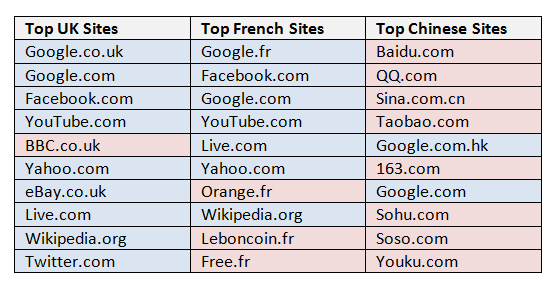For businesses whose success is strongly tied to an online strategy, there are a variety of factors to consider when thinking about your domain and brand as part of global expansion. This article will outline some of the major considerations and help provide a loose framework that can be used to design and evaluate your brand and domain with regard to expanding globally.
The framework I’m going to propose is based on the assumption that the goal of international expansion is acquisition. “Acquisition” can be defined in a variety of terms (e.g. revenue, customers) however the point here is that the main goal is quantifiable acquisition and subsequently, all considerations should be oriented around the achievement of that goal.
1. How does your existing domain perform in the target market?
One of the first places to look is at the performance of your existing domain in the target market. For example, if your conversion rates from the international target market on your domain are consistent with your conversion rates in your intended, native market, then that is worth knowing. If your current domain is performing well in organic search for your international target market, then that is also good to know. It’s unlikely that either of these things will happen but it’s always possible.
2. Will your brand translate well to the target market?
Some brands have more global potential than others. For example, a brand like Lyris is likely more globally adaptable than a brand like Constant Contact. Lyris, which doesn’t really mean anything in English, is short, language-agnostic, relatively easy to remember, and relatively type-able. Those attributes are likely to translate to global markets fairly well. Constant Contact on the other hand, has a very explicit connotation in English that is likely to create issues if used abroad. The recall and type-ability of Constant Contact are tied to the semantic connotation of the words used. In the absence of its semantic inference, it is really just a long domain name that scores below average on type-ability and recall.
3. How important is organic search to your success?
Google looks for signals such as the top-level-domain (TLD), country where your site is hosted and the geographic target (you can configure this in Google webmaster tools) as signals that will help in determining the performance of your domain in country-specific search. In general, the optimal configuration would be to have a domain that is hosted in your target country with a TLD for that country.
Take for example, the country-neutral query, “preparing for a job interview” and its performance in both Google.com and Google.co.uk. In Google.com, each of the top 10 results is from a .com that is hosted in the United States. In Google.co.uk however, the picture changes dramatically.
Google.co.uk search results for “preparing for a job interview” with .co.uk results highlighted
The first result came from a .co.uk TLD, as did results six, seven and eight. Results three, four, nine and ten came from .com domains hosted in the UK. In fact, only one out of the top ten results in Google.co.uk for “preparing for a job interview” comes from a .com hosted in the US.
It should be noted that there is something to be gained from hanging a sub-domain or sub-folder off a domain that already has search authority. This approach will give you a bit of a head start but in the long run, having a country-specific TLD and hosting your content in your target country is likely to perform better.
4. Are you expanding East?
Whether it be due to language differences, nationalism or government imposed restrictions is up for debate. What is not up for debate is the simple fact that in China, the best performing sites have Chinese domains. No major American brand has been able to achieve market dominance in China and only Google has been able to achieve significant traction.
Top Online Properties in the UK, France and China (according to Alexa)
For whatever reason, Chinese consumers seem to prefer Chinese brands and from a domain perspective, its worth considering whether a Chinese-friendly domain is the way to go.
5. Are you able to procure the domains you want in your target market?
There is always the question of procurement. Domain squatting has been around for ages but as the market is becoming increasingly global, so follows the practice of cross-national domain squatting. This (very irritating) practice has become a reality for even smaller, emerging brands. Figuring out the logistics behind domain acquisition is an important variable.
6. What is your global brand strategy?
For some, a domain strategy should be considered in the context of a broader brand strategy. Does your long-term corporate vision involve tje development of a globally recognized brand, or is your corporate strategy to simply build individual brands that speak more directly to target audiences in different countries? If you’re successful at the latter, you may soon find yourself juggling a handful of brands. On the other hand, a the approach does allow you greater flexibility in domain & brand targeting.
7. Avoid dogma
Ultimately, it’s all about approaching the game with an open mind. Being prepared for failure, recalibration and iteration is normally going to be more successful over the years than zeroing in on one specific approach. No one ever said that launching multiple domains is a bad idea – it just requires more resources. Ultimately, it’s useful to acknowledge that the Internet is a dynamic landscape and the home run iteration is rarely the first.


0 Comments on "Domain Name considerations when going international"